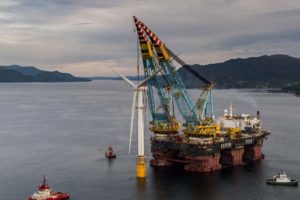I nternational energy company Statoil is building Hywind: the world’s first floating wind farm, just off the Scottish coast, UK. Statoil has adapted the same technology used for its floating oil facilities, known as spar platforms, to revolutionise the way wind farms operate. The Hywind facility places conventional wind turbines on top of floating steel cylinders, which are held in place by cables and suction anchors. The cylinders float 78 metres below sea level and hold large pockets of air. This works to keep the turbines afloat, much like a ship’s hull.
nternational energy company Statoil is building Hywind: the world’s first floating wind farm, just off the Scottish coast, UK. Statoil has adapted the same technology used for its floating oil facilities, known as spar platforms, to revolutionise the way wind farms operate. The Hywind facility places conventional wind turbines on top of floating steel cylinders, which are held in place by cables and suction anchors. The cylinders float 78 metres below sea level and hold large pockets of air. This works to keep the turbines afloat, much like a ship’s hull.
The wind farm installations are being constructed off the west coast of Norway, where the 162-metre tall turbines are loaded onto the floating steel cylinders by the world’s second largest crane vessel, the Saipem 7000. After they are assembled, the floating units are towed across the North Sea to the coast of Scotland where they will provide power to Scottish homes.
“We believe this technology is a game changer,” says Elin Isaksen, Communication Leader at Statoil. “Lots of shores are actually too deep for conventional turbines, so we believe fixed installations are the only viable alternative in many areas.”
Hywind demonstrates that steel has a crucial role to play in the development of sustainable energy resources. Offshore wind farms face rough weather conditions and sturdy, safe materials are vital to their success. Hywind shows that old-fashioned reliability and strength is the key to innovation and sustainability.
A major advantage of floating wind farms is that they can be built in areas unsuitable for traditional wind farms. Fixed windmills can only be built in waters up to 60 metres deep. These restrictions do not apply to floating wind farms, which can benefit from stronger winds in deepwater areas.
Statoil believes the Hywind project will revolutionise the way offshore wind farms are built. Traditional turbines need to be custom made, but floating windmills can be produced on an industrial scale. The cost per megawatt has already been reduced by 60 per cent since Hywind’s initial pilot project.
In the long run, production costs of floating wind farms could go down even more as Statoil actively looks to expand its existing supplier network and build a global supply chain.



